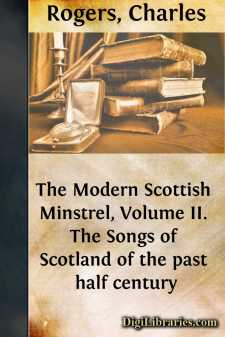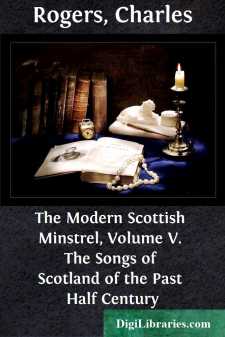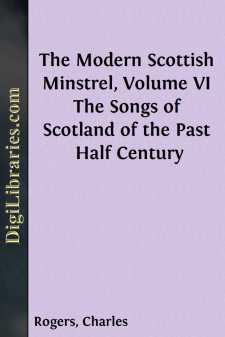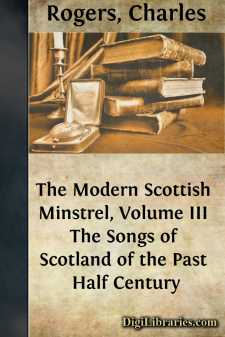Categories
- Antiques & Collectibles 13
- Architecture 36
- Art 48
- Bibles 22
- Biography & Autobiography 813
- Body, Mind & Spirit 141
- Business & Economics 28
- Children's Books 12
- Children's Fiction 9
- Computers 4
- Cooking 94
- Crafts & Hobbies 4
- Drama 346
- Education 46
- Family & Relationships 57
- Fiction 11826
- Games 19
- Gardening 17
- Health & Fitness 34
- History 1377
- House & Home 1
- Humor 147
- Juvenile Fiction 1873
- Juvenile Nonfiction 202
- Language Arts & Disciplines 88
- Law 16
- Literary Collections 686
- Literary Criticism 179
- Mathematics 13
- Medical 41
- Music 40
- Nature 179
- Non-Classifiable 1768
- Performing Arts 7
- Periodicals 1453
- Philosophy 64
- Photography 2
- Poetry 896
- Political Science 203
- Psychology 42
- Reference 154
- Religion 513
- Science 126
- Self-Help 83
- Social Science 81
- Sports & Recreation 34
- Study Aids 3
- Technology & Engineering 59
- Transportation 23
- Travel 463
- True Crime 29
The Modern Scottish Minstrel, Volume II. The Songs of Scotland of the past half century
by: Charles Rogers
Categories:
Description:
Excerpt
INTRODUCTION
TO
The Modern Gaelic Minstrelsy.
The suspicion which arose in regard to the authenticity of Ossian, subsequent to his appearance in the pages of Macpherson, has unjustly excited a misgiving respecting the entire poetry of the Gael. With reference to the elder poetry of the Highlands, it has now been established that at the period of the Reformation, the natives were engrossed with the lays and legends of Bards and Seanachies, of which Ossian, Caoillt, and Cuchullin were the heroes. These romantic strains continued to be preserved and recited with singular veneration. They were familiar to hundreds in different districts who regarded them as relics of their ancestors, and would as soon have mingled the bones of their fathers with the dust of strangers, as ventured on the alteration of a single passage. Many of the reciters of this elder poetry were writers of verses, yet there is no instance of any attempt to alter or supersede the originals. Nor could any attempt have succeeded. There are specimens which exist, independent of those collected by Macpherson, which present a peculiarity of form, and a Homeric consistency of imagery, distinct from every other species of Gaelic poetry.
Of an uncertain era, but of a date posterior to the age of Ossian, there is a class of compositions called Ur-sgeula, or new-tales, which may be termed the productions of the sub-Ossianic period. They are largely blended with stories of dragons and other fabulous monsters; the best of these compositions being romantic memorials of the Hiberno-Celtic, or Celtic Scandinavian wars. The first translation from the Gaelic was a legend of the Ur-sgeula. The translator was Ierome Stone, schoolmaster of Dunkeld, and the performance appeared in the Scots Magazine for 1700. The author had learned from the monks the story of Bellerophon, along with that of Perseus and Andromeda, and from these materials fabricated a romance in which the hero is a mythical character, who is supposed to have given name to Loch Fraoch, near Dunkeld. Belonging to the same era is the "Aged Bard's Wish," a composition of singular elegance and pathos, and remarkable for certain allusions to the age and imagery of Ossian. This has frequently been translated. Somewhat in the Ossianic style, but of the period of the Ur-sgeula are two popular pieces entitled Mordubh and Collath. Of these productions the imagery is peculiarly illustrative of the character and habits of the ancient Gael, while they are replete with incidents of the wars which the Albyn had waged with their enemies of Scandinavia. To the same period we are disposed to assign the "Song of the Owl," though it has been regarded by a respectable authority as of modern origin. Of a portion of this celebrated composition we subjoin a metrical translation from the pen of Mr William Sinclair.
The Bard, expelled from the dwellings of men by plunderers according to one account, by a discontented helpmate according to another, is placed in a lone out-house, where he meets an owl which he supposes himself to engage in an interchange of sentiment respecting the olden time:—
Hunter....








